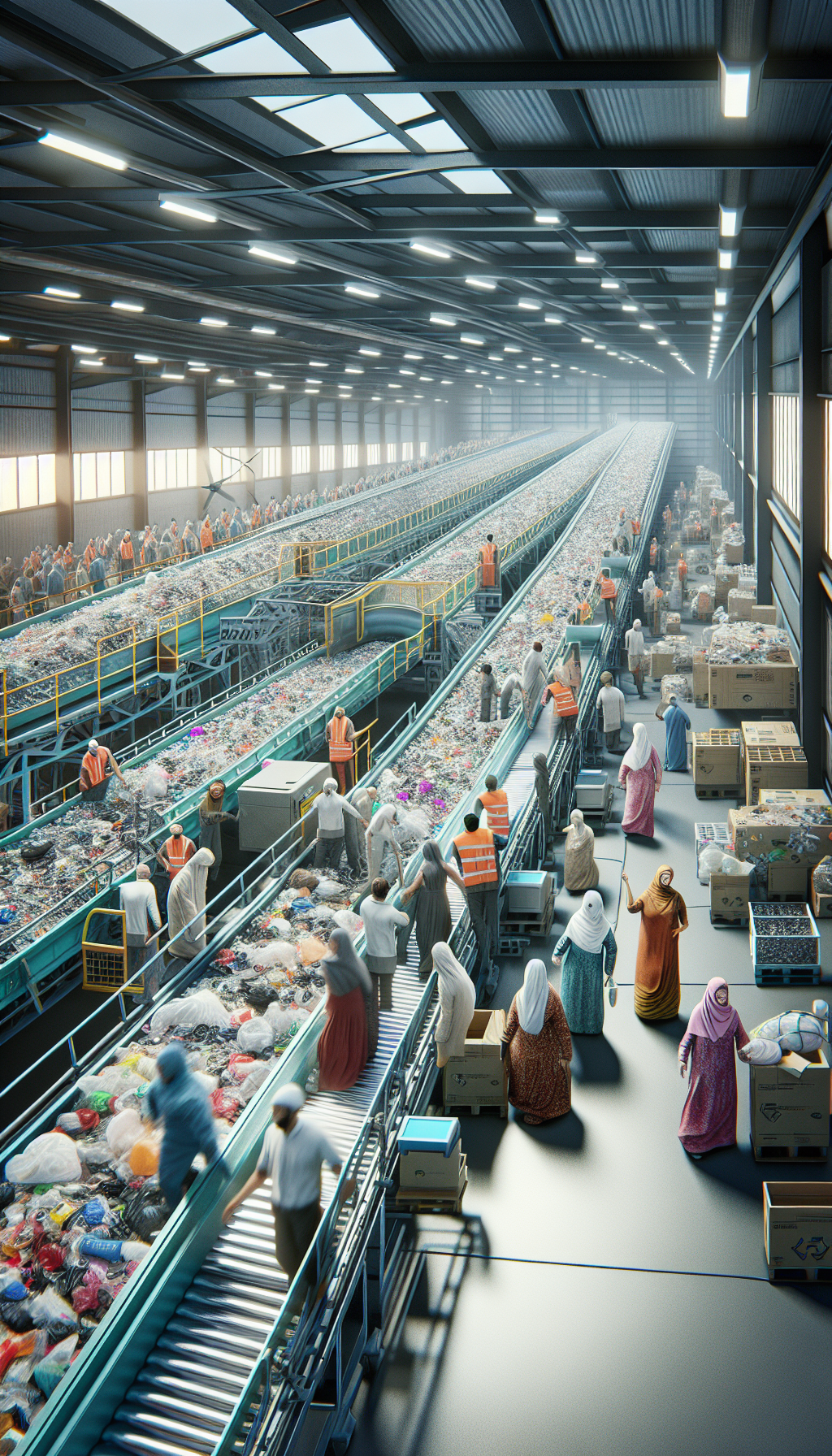Understanding Recycling and Its Importance
Recycling plays a crucial role in promoting environmental sustainability by transforming waste materials into new, usable products. This process not only helps in reducing the volume of waste sent to landfills but also conserves natural resources. By recycling materials such as paper, glass, metals, and plastics, societies can significantly reduce the environmental impact associated with the extraction and processing of virgin materials. Moreover, recycling can lead to substantial energy savings because manufacturing products from recycled materials often requires less energy compared to producing them from raw materials.
One of the key aspects of recycling is its ability to lower carbon emissions. The reduction in energy consumption directly translates to fewer greenhouse gases being emitted into the atmosphere. For example, recycling aluminum saves about 95% of the energy needed to produce new aluminum from bauxite ore. This significant energy saving underscores the importance of recycling in combating climate change and reducing our carbon footprint. Additionally, recycling helps in preserving biodiversity by reducing the need for raw material extraction, which often leads to habitat destruction.
- Reduction in Waste: Recycling helps decrease the amount of waste that ends up in landfills and incinerators.
- Conservation of Resources: By reprocessing materials, recycling conserves natural resources such as timber, water, and minerals.
- Energy Savings: The energy required to recycle materials is generally much less than the energy needed to produce new products from raw materials.
To illustrate the impact of recycling, consider the following data:
| Material | Energy Savings (%) |
|---|---|
| Aluminum | 95% |
| Steel | 60-74% |
| Paper | 40% |
| Plastics | 33% |
These figures demonstrate the significant benefits of recycling and emphasize the importance of expanding recycling efforts worldwide. By understanding and implementing recycling practices, communities can move towards a more sustainable future, ensuring that resources are available for generations to come.
The Environmental Impact of Waste
Waste management is a critical component of environmental sustainability, as the improper handling of waste leads to severe ecological consequences. The accumulation of waste in landfills contributes significantly to soil and water pollution. As waste decomposes, harmful chemicals and toxins can leach into the ground, contaminating local ecosystems. Moreover, landfills are a major source of methane emissions, a potent greenhouse gas that exacerbates climate change.
Recycling plays a pivotal role in mitigating these impacts. By diverting waste from landfills, recycling reduces the volume of waste that contributes to pollution and greenhouse gas emissions. Innovative recycling technologies further enhance this benefit by increasing the efficiency and effectiveness of the recycling process. For instance, advancements in sorting technologies have improved the separation of recyclable materials, ensuring that more materials are processed and reused.
The environmental impact of waste is not just confined to local ecosystems; it has far-reaching global implications. The extraction and processing of raw materials for new products require significant energy and resources, further depleting the earth’s natural reserves. By recycling materials, we reduce the demand for new raw materials, thereby conserving natural resources and minimizing energy consumption. This conservation effort is crucial in the fight against climate change, as it leads to a substantial decrease in carbon emissions associated with manufacturing processes.
| Impact | Effect |
|---|---|
| Soil and Water Pollution | Contamination of ecosystems through leachate |
| Methane Emissions | Increased greenhouse gases, contributing to climate change |
| Resource Depletion | Increased use of energy and raw materials |
Through global efforts and policies aimed at increasing recycling rates, countries are working towards a more sustainable future. By adopting comprehensive waste management strategies, including recycling, composting, and waste-to-energy technologies, we can significantly reduce the environmental impact of waste, paving the way for a greener and more sustainable planet.
The Life Cycle of Recyclable Materials
The life cycle of recyclable materials is a comprehensive process that plays a critical role in promoting environmental sustainability. It begins with the collection of materials, which are then sorted and cleaned to ensure they meet the necessary quality standards for recycling. Collection can occur through curbside programs, drop-off centers, or deposit/refund schemes, each designed to maximize the recovery of materials. Once collected, the materials undergo sorting where advanced technologies like infrared sensors and magnetic systems are employed to separate items based on their composition, such as metals, plastics, and paper.
After sorting, the materials are cleaned to remove any contaminants that could hinder the recycling process. This step is crucial for maintaining the integrity and quality of the final recycled product. The cleaned materials are then transformed into raw materials through processes like shredding, melting, or pulping. For instance, plastics might be melted down and reformed, while paper products are pulped to create new paper. These raw materials are subsequently used to produce new products, effectively closing the recycling loop and significantly reducing the need for virgin resources.
The environmental benefits of this life cycle are substantial. By recycling materials, we can significantly reduce the volume of waste sent to landfills and decrease the consumption of natural resources. According to a recent report, recycling aluminum saves 95% of the energy required to produce the same amount from raw materials. Similarly, recycling paper can save up to 60% of the energy compared to new paper production. This energy conservation leads to a reduction in carbon emissions, contributing to the fight against climate change.
Furthermore, the life cycle of recyclable materials is enhanced by innovative technologies and global efforts focused on increasing efficiency and effectiveness. Countries around the world are investing in state-of-the-art recycling facilities and implementing policies to encourage recycling at both the individual and corporate levels. These initiatives are crucial for overcoming challenges such as contamination and the fluctuating market for recycled materials. By advancing the life cycle of recyclable materials, we can drive towards a more sustainable and environmentally friendly future.
Economic Benefits of Recycling
Recycling is not only a key component in promoting environmental sustainability, but it also offers significant economic advantages. By transforming waste materials into valuable resources, recycling helps create jobs and stimulate economic growth. According to the U.S. Environmental Protection Agency, the recycling industry supports over 1.1 million jobs and generates billions in annual revenue. These jobs are diverse, ranging from collection and processing to manufacturing new products from recycled materials.
Beyond job creation, recycling contributes to economic stability by reducing the costs associated with waste disposal. Municipalities spend millions annually on landfill operations, and recycling helps alleviate this financial burden. For instance, a study found that cities can save an average of $50 for each ton of waste diverted from landfills to recycling centers. This cost saving can be redirected to other essential services, benefiting local communities.
Moreover, recycling can lower production costs for manufacturers. Recycled materials often require less energy to process compared to raw materials. For example, producing aluminum from recycled materials uses 95% less energy than creating it from bauxite ore. This reduction in energy consumption translates to lower utility bills and production costs, allowing businesses to invest more in innovation and expansion.
To illustrate these benefits, consider the following data table:
| Material | Energy Savings (%) | Cost Savings per Ton ($) |
|---|---|---|
| Aluminum | 95 | 1,000 |
| Steel | 60 | 200 |
| Paper | 40 | 50 |
Reducing Carbon Footprint Through Recycling
Recycling plays a crucial role in reducing the carbon footprint associated with manufacturing and waste management processes. By reusing materials, we can significantly decrease the demand for raw material extraction, which is often energy-intensive and a major source of greenhouse gas emissions. According to a study by the Environmental Protection Agency, recycling aluminum cans saves 95% of the energy required to produce the same amount of aluminum from raw materials.
In addition to energy savings, recycling helps in lowering carbon emissions by minimizing the need for new product manufacturing. For example, recycling one ton of paper can save around 17 trees and 7,000 gallons of water, and reduce greenhouse gas emissions by one metric ton of carbon equivalent. This demonstrates the substantial impact recycling can have on conserving resources and reducing carbon emissions. Below is a table illustrating the energy savings and carbon reduction associated with recycling different materials:
| Material | Energy Savings (%) | Carbon Reduction (Metric Tons CO2) |
|---|---|---|
| Aluminum | 95% | 10 |
| Paper | 60% | 1 |
| Plastic | 70% | 1.4 |
| Glass | 30% | 0.3 |
Moreover, innovative recycling technologies are enhancing the efficiency of recycling processes, thereby amplifying their environmental benefits. Advanced sorting technologies, such as optical sorters and artificial intelligence, are improving the accuracy and speed of material recovery, ensuring that more recyclable materials are efficiently processed and fewer end up in landfills. As technology continues to evolve, the potential for further reductions in carbon emissions through recycling will likely grow, contributing significantly to global sustainability efforts.
Recycling and Natural Resource Conservation
Recycling plays a crucial role in conserving natural resources, which are finite and often depleted due to excessive consumption and extraction. By transforming waste materials into reusable resources, recycling reduces the need to extract raw materials from the earth, thus preserving natural habitats and biodiversity. For instance, recycling one ton of paper can save approximately 17 trees, 7,000 gallons of water, and 4,100 kilowatts of electricity. This conservation of resources helps maintain ecological balance and supports the sustainability of ecosystems.
Moreover, the recycling of metals such as aluminum and steel significantly reduces the need for mining, an activity that can cause extensive environmental damage. Aluminum recycling is particularly effective, as it uses only 5% of the energy required to produce new aluminum from bauxite ore. This substantial energy saving translates to fewer fossil fuels burned and a reduction in greenhouse gas emissions. The following table illustrates the energy savings and environmental benefits of recycling various materials:
| Material | Energy Saved (%) | Environmental Benefits |
|---|---|---|
| Aluminum | 95% | Reduction in mining; decreased carbon emissions |
| Steel | 60-74% | Less mining required; reduced water pollution |
| Paper | 40% | Conservation of trees and water resources |
| Plastic | 70% | Less petroleum used; reduced landfill waste |
In addition to conserving resources, recycling supports the development of sustainable technologies that further enhance resource efficiency. Innovative methods such as chemical recycling and advanced sorting technologies are emerging, allowing for the recycling of complex materials and improving the purity of recycled outputs. These advancements not only increase the effectiveness of recycling programs but also expand the range of materials that can be recycled, ultimately leading to a more sustainable future.
Innovative Recycling Technologies
Innovative recycling technologies are at the forefront of promoting environmental sustainability by enhancing the efficiency and scope of recycling processes. These technologies include advancements in sorting mechanisms, chemical recycling, and the development of biodegradable materials. Automated sorting systems have revolutionized the recycling industry by utilizing sensors and artificial intelligence to accurately separate materials based on their type and quality. This not only increases the purity of recycled materials but also significantly reduces contamination, leading to higher quality end products.
The introduction of chemical recycling has opened new avenues for processing plastics that were traditionally considered non-recyclable. Unlike mechanical recycling, which often degrades the quality of plastics, chemical recycling breaks down polymers into their basic monomers, allowing them to be remolded without loss of integrity. This process not only extends the lifecycle of plastics but also reduces the demand for virgin materials, conserving natural resources and reducing the energy consumption associated with new production.
Another promising area is the development of biodegradable materials that can be easily recycled or decomposed without harming the environment. Researchers are focusing on creating materials from renewable sources such as plant-based polymers, which degrade naturally and are compostable. The adoption of these materials can potentially reduce the burden on recycling systems and cut down the volume of waste directed to landfills.
These technologies are supported by global efforts and policies aimed at fostering sustainable practices. Many countries are investing in recycling infrastructure and encouraging innovation through incentives and strict regulations. The collective emphasis on recycling innovation not only addresses the current challenges of waste management but also paves the way for a more sustainable future. The following table highlights some key technologies and their environmental benefits:
| Technology | Environmental Benefit |
|---|---|
| Automated Sorting Systems | Improves material purity and reduces contamination |
| Chemical Recycling | Enables recycling of complex plastics, conserving resources |
| Biodegradable Materials | Reduces landfill waste and pollution |
Community Involvement in Recycling Initiatives
Community involvement plays a crucial role in the success of recycling initiatives. By actively participating in recycling programs, communities can significantly enhance the efficiency and impact of these efforts. Local governments and organizations often spearhead campaigns to encourage residents to recycle more effectively, providing educational resources and incentives to foster participation. These initiatives can include curbside recycling programs, drop-off centers, and educational workshops that teach proper sorting and disposal techniques.
One successful approach to engaging communities is through awareness campaigns that highlight the environmental and economic benefits of recycling. These campaigns often utilize data and visual aids to convey the impact of community efforts. For instance, a recycling drive might show how many tons of waste have been diverted from landfills due to community action. Consider the following data visualization that illustrates the positive impact of increased recycling rates:
| Year | Recycling Rate (%) | Waste Diverted (tons) |
|---|---|---|
| 2020 | 35 | 500,000 |
| 2021 | 40 | 600,000 |
| 2022 | 45 | 700,000 |
Community recycling initiatives also benefit from collaborative efforts between local businesses, schools, and civic groups. These partnerships can lead to innovative recycling solutions tailored to the needs of the community. For example, schools might implement recycling education into their curriculums, while local businesses could sponsor recycling bins or host recycling events. An organized community cleanup day not only helps reduce litter but also raises awareness about the importance of recycling and environmental stewardship.
Involving communities in recycling efforts fosters a sense of ownership and responsibility, encouraging individuals to adopt sustainable practices in their daily lives. Through collective action, communities can drive significant progress towards environmental sustainability, demonstrating the power of grassroots involvement in the global recycling movement.
Challenges in Recycling Systems
Although recycling is a pivotal component of promoting environmental sustainability, it faces several significant challenges that hinder its effectiveness. One major issue is the contamination of recyclable materials. When non-recyclable items are mixed with recyclables, it can lead to entire batches being sent to landfills instead of being processed. This contamination not only increases waste but also raises the cost of recycling operations as additional sorting and cleaning are required.
Another challenge is the lack of standardized recycling practices and regulations across different regions and countries. This inconsistency can cause confusion among consumers about what materials can be recycled, leading to lower participation rates in recycling programs. Moreover, the absence of uniform standards makes it difficult to create a cohesive global effort towards recycling, as materials processed in one country may not be accepted in another, disrupting the recycling supply chain.
The recycling industry also faces economic challenges. Fluctuations in the market value of recyclable materials can make recycling financially unviable, especially for materials like glass and certain plastics. Additionally, the initial investment cost for advanced recycling technologies can be prohibitive for many municipalities. This financial instability can deter the development and implementation of innovative recycling solutions that are essential for enhancing sustainability.
To illustrate these challenges, consider the following data visualization outlining common recycling obstacles:
| Challenge | Impact |
|---|---|
| Contamination | Increased waste and operational costs |
| Lack of Standardization | Confusion and reduced participation |
| Economic Viability | Financial instability and deterrence of innovation |
Global Success Stories in Recycling
Recycling initiatives across the globe have showcased remarkable success stories, setting benchmarks for environmental sustainability. One exemplary model is Sweden, where innovative waste management strategies have led to less than 1% of household waste ending up in landfills. Instead, Sweden has developed a robust system that emphasizes the recycling and energy recovery of waste materials. The country’s commitment to a circular economy is further demonstrated by its investment in advanced technologies that convert waste into energy, significantly reducing the reliance on fossil fuels.
Germany stands out as another leader in recycling, with a comprehensive system that recycles nearly 70% of its waste. This success is attributed to the Duales System Deutschland (DSD), which encourages producers to take responsibility for their packaging waste. The system has not only increased the recycling rate but also influenced packaging designs to be more sustainable. As a result, Germany has significantly reduced its carbon footprint, contributing to its ambitious goals for climate protection.
In Asia, Japan’s recycling efforts have garnered attention, particularly in electronic waste management. The country’s Home Appliance Recycling Law mandates the recycling of large electronics such as televisions, air conditioners, and refrigerators. This initiative has led to the recovery of valuable metals and materials, reducing the need for raw material extraction. Japan’s success is further supported by public awareness campaigns that educate citizens on the importance of recycling and waste segregation.
These global success stories demonstrate the potential of recycling as a powerful tool for environmental sustainability. They highlight the importance of government policies, technological innovation, and public participation in achieving high recycling rates. The lessons learned from these countries can serve as a model for other nations striving to enhance their recycling capabilities and contribute to a greener future.
Policy and Legislation Supporting Recycling
Policy and legislation play a crucial role in promoting recycling practices that contribute to environmental sustainability. Governments around the world have introduced various laws and regulations to encourage the recycling of materials, aiming to reduce waste and conserve natural resources. These policies often include incentives for businesses and individuals to participate in recycling programs, as well as penalties for non-compliance. For instance, the European Union has implemented the Waste Framework Directive, which sets targets for recycling and waste reduction, pushing member states to improve their recycling infrastructures.
In the United States, the Resource Conservation and Recovery Act (RCRA) provides the framework for the proper management of hazardous and non-hazardous solid waste. This legislation empowers the Environmental Protection Agency (EPA) to oversee and enforce recycling regulations, ensuring compliance across states. Additionally, many states have their own recycling laws that complement federal legislation, such as California’s Mandatory Commercial Recycling Law, which requires businesses to recycle as part of their waste management strategy.
The impact of these policies is highlighted in various data visualizations, demonstrating the progress and challenges in recycling efforts globally. For example, a table summarizing recycling rates in different countries can provide insights into how policy effectiveness varies across regions:
| Country | Recycling Rate (%) | Key Legislation |
|---|---|---|
| Germany | 66 | Circular Economy Act |
| South Korea | 59 | Act on the Promotion of Saving and Recycling of Resources |
| United States | 35 | Resource Conservation and Recovery Act (RCRA) |
Moreover, international cooperation and agreements are essential in enhancing recycling efforts across borders. Agreements such as the Basel Convention regulate the transboundary movements of hazardous wastes and promote environmentally sound waste management practices. By aligning policies and sharing best practices, countries can collectively tackle the global challenge of waste management and drive towards a more sustainable future.
Future Trends in Recycling and Sustainability
As the world continues to grapple with environmental challenges, the future of recycling is being shaped by innovative technologies and global initiatives aimed at enhancing sustainability. One of the most promising trends is the development of advanced sorting technologies that utilize artificial intelligence and machine learning to efficiently separate recyclable materials from waste. These technologies not only improve the quality of recycled materials but also reduce contamination rates, making recycling processes more efficient and cost-effective. Additionally, there is a growing emphasis on the use of biodegradable materials and the promotion of a circular economy, where products are designed for reuse and recycling, thereby minimizing waste generation.
Global efforts are also focused on increasing recycling rates and reducing reliance on landfills. Several countries are implementing stringent policies and incentives to encourage recycling and sustainable waste management practices. For example, the European Union has set ambitious targets to recycle 70% of packaging waste by 2030. In the United States, cities like San Francisco are leading the way with zero-waste initiatives that aim to divert all waste from landfills. These efforts are supported by public awareness campaigns and educational programs that highlight the importance of recycling and its impact on environmental sustainability.
Data from various studies underscore the positive impact of these trends on environmental sustainability. According to a recent report, if global recycling rates were to increase by just 10%, it could lead to a reduction of over 600 million tons of carbon dioxide emissions annually. This highlights the potential of recycling to mitigate climate change and promote a healthier planet. The following table showcases some key statistics related to recycling and its environmental benefits:
| Recycling Rate Increase | CO2 Emissions Reduction (Million Tons) |
|---|---|
| 5% | 300 |
| 10% | 600 |
| 15% | 900 |
In conclusion, the future of recycling holds great promise for advancing environmental sustainability. With the integration of cutting-edge technologies and strong global commitments, recycling is poised to play a crucial role in reducing waste, conserving resources, and lowering greenhouse gas emissions. As these trends continue to evolve, they will be instrumental in shaping a more sustainable and resilient future for our planet.



